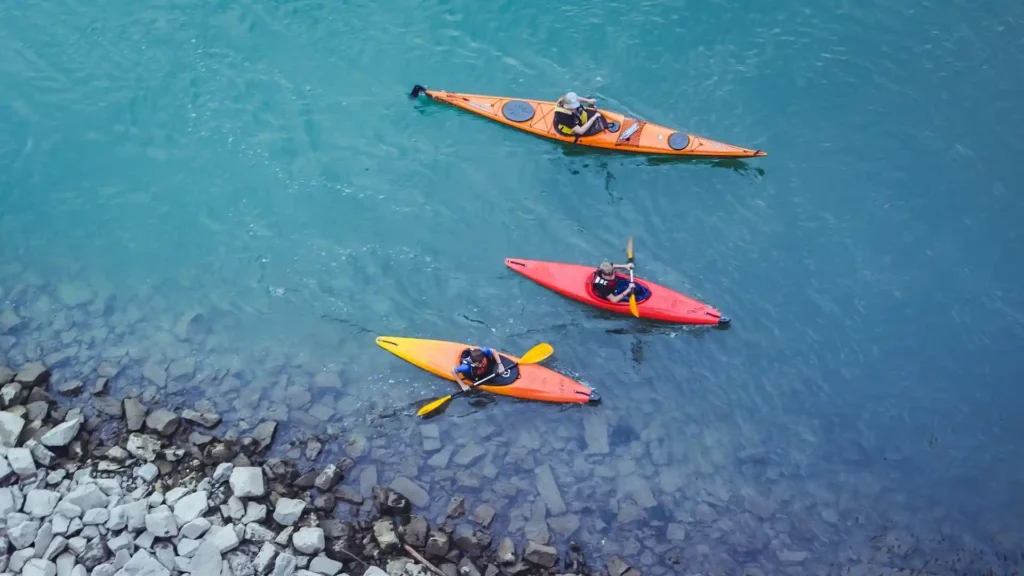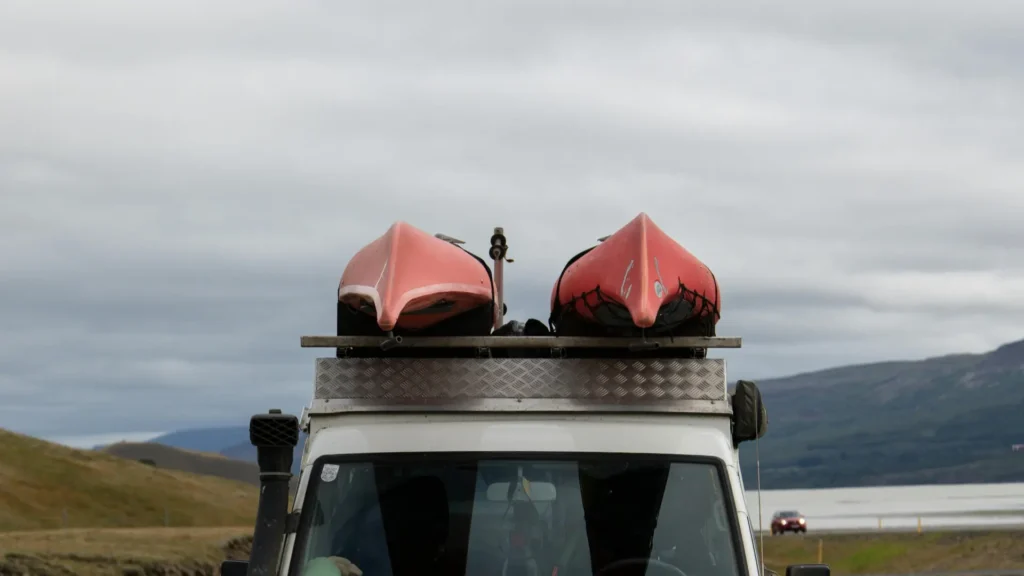To enjoy a thrilling kayaking, you have to learn it first. Study the basic skills of kayaking, learn them and get on board for the best experience. In the beginning, learning may seem daunting, but in the end, it is thrilling.
In this guide, we’ll walk you through the essential steps to becoming a confident and skilled kayaker.
Understanding Kayak Basics and Safety
You have to understand the basic equipment, kayak types and safety protocols before getting into the water. Kayaking isn’t just paddling. It’s essential to be familiar with your kayak and how to stay safe on the water.
Kayak Types and Equipment
There are different types of kayaks designed for various water conditions. Different types of kayaks are used for various purposes. Below is a list of kayak types –
- Touring kayaks
- Whitewater kayaking
- Inflatable kayaks
- Recreational kayaks
- Sit on top kayaks
- Sea kayaks
- Tandem kayaks
- Fishing kayaks
- Folding kayaks
- Pedal kayaks
- Sit-in kayaks
- Surf kayaking
- Crossover kayaks
- Junior Kayaks
- Racing Kayaks
- River Runners
- Creekboats
- Diving kayaks
- Playboats
- Rigid kayak
- Sail kayaks
- Hybrid kayak
- Modular kayaks
- Sit-on-top
As a beginner, you should opt for a kayak that is stable and easy to use on water. And the characteristics of the water should be calm. At the beginning, choose kayaking in lakes, rivers, and bays, and avoid whitewater. Regarding on these aspects, recreational kayaks are the best option, according to most experts, for the beginners.
A good beginner kayak should be stable, easy to maneuver, and provide comfort for your body. Start with a sit-on-top kayak if you’re new to kayaking, as they offer more stability.
Safety First
Be prepared before the hazards come. You don’t know what is going to happen, even in calm water. For this reason, water safety is paramount for any kayaker.
Before embarking on any kayaking adventure, you should always wear a life jacket (PFD), regardless of your skill level, whether you can swim or not. This is particularly important in unpredictable water conditions. Even in calm waters, you never know what could happen — it’s better to be over-prepared than to take risks.
Your kayak can capsize any time. So, in addition to wearing a life jacket, learning the proper techniques for re-entering the kayak, after capsizing, is crucial.
You should practice a controlled capsizing scenario and get comfortable flipping the kayak back over and climbing back into it. This is a basic kayaking lesson, in your learning process, to ensure that you’re prepared for any unexpected situation.
Mastering Basic Paddle Techniques
Now, you know your kayak and the basic safety measures. This is the time to learn how to paddle effectively. The paddle is your primary tool for propelling the kayak and steering it, and learning the correct techniques is essential for both speed and safety.
Holding the Paddle
The paddle has two blades: one for each side of the kayak. To begin, hold the paddle with your hands placed about shoulder-width apart. Your grip should be firm but not too tight.
According to George Miller, a professional kayaking instructor with the National Outdoor Leadership School (NOLS), “A relaxed grip is key for avoiding muscle fatigue. The paddle should feel like an extension of your arms.”
Basic Strokes
The basic strokes you’ll need to learn are the forward stroke, reverse stroke, and sweep stroke.
Forward Stroke: This is the basic stroke that propels your kayak forward. Use alternating strokes on either side of the kayak, keeping the paddle blade close to the boat. The stroke should come from your torso, not just your arms.
Reverse Stroke: To reverse direction, use the reverse stroke. This is very easy, just paddle backward in a similar manner to the forward stroke.
Sweep Stroke: This stroke is used to turn the kayak. By making a wide, sweeping arc with the paddle on one side of the kayak, you can guide the boat in the desired direction.
Balancing and Steering the Kayak
One of the most challenging aspects for beginners is learning how to balance in the kayak and steer effectively. Unlike many other water sports, kayaking requires constant adjustments to maintain stability and navigate the water.
Staying Stable
In the beginning, learning kayak seems impossible and staying balanced in the kayak can feel like a delicate task.
To maintain your position, you should focus on maintaining a neutral posture, sitting up straight with a relaxed lower back and slightly bent knees. Your core should remain engaged for better control and stability.
Beginner kayakers often struggle with the fear of tipping over. Once you get used to the sensation of sitting in the kayak, it becomes second nature.
Steering and Turning
Steering the kayak involves using your paddle effectively to make subtle adjustments in direction. In addition to the sweep stroke, other turning techniques like the J-stroke can help beginners control the kayak more efficiently.
When paddling, your body and weight play a critical role in the kayak’s movement. By shifting your weight slightly, you can make turns or correct any drifting caused by wind or current.
Building Confidence on Calm Waters
Choose calm and flat water for kayaking. Lakes, ponds, and slow-moving rivers are ideal starting points. These environments allow you to focus on learning without the added pressure of waves, currents, or strong winds.
Start by practicing simple maneuvers, like:
- paddling straight ahead
- making turns
- stopping
Start small at the beginning. You can automatically find out mistakes you are doing when kayaking. Over time, you will gain skills. Like other learning procedures, practice is the king. As you grow more comfortable, you can extend your paddling sessions and practice paddling for longer periods. It will be your second nature very soon.
Handling Obstacles and Conditions
Once you’re a confident paddler, start exploring slightly more challenging conditions, such as mild currents or small waves, but don’t go for big, like whitewater kayaking.
Learning to navigate obstacles, such as rocks and fallen trees, is an essential part of kayaking. At first, these obstacles may seem overwhelming, but over time, you will start to enjoy them.
It’s important to stay relaxed when approaching obstacles. Use your paddle to make small, controlled strokes, and avoid jerky movements.
Improving Strength and Endurance
Kayaking requires the use of your upper body and core muscles. As you continue practicing, you’ll notice improvements in your endurance and overall strength.
Longer paddling sessions will help you develop stamina, while also improving your efficiency and speed on the water.
To build these muscles outside of kayaking, cross-training activities like swimming, weightlifting, and yoga can be beneficial. But they aren’t mandatory. Your general physical activities are enough.
Expanding Your Skills: Advanced Techniques and New Challenges
If you are eager to progress, there are several advanced techniques and more challenging water conditions to explore. As you gain experience, you can begin practicing more technical maneuvers like
- edging – tilting the kayak for sharper turn, and
- bracing – a technique to prevent capsizing in rough water
For advanced kayakers, sea kayaking or whitewater kayaking introduces entirely new challenges, including navigating waves, handling rapid currents, and learning rescue techniques.
Joining the Kayaking Community
It is wise to join a kayaking community when you start learning. Joining a local kayaking group or participating in guided tours can provide both social and learning opportunities. You will get a relevant and practical guide there. It’s also a great way to stay motivated and learn from others.
Enjoy the Journey and Keep Learning
Kayaking, like any skills, improves with practice. Learning the basics is the groundwork to mastering the advanced techniques. Your continuous practice and experience will make you confident and capable on the water, while also building physical fitness and mental resilience.




